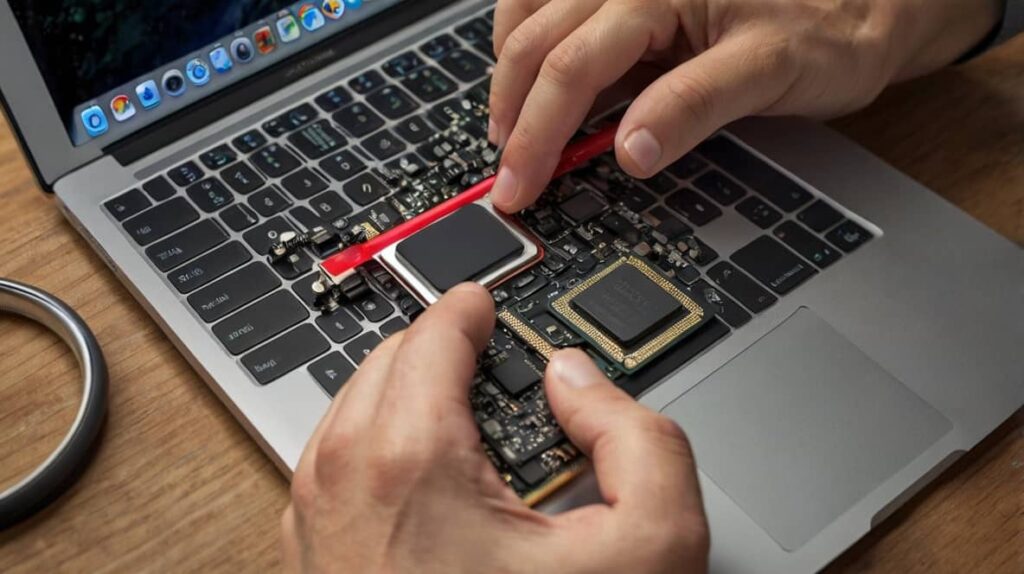The CPU (Central Processing Unit) is the heart of your computer, responsible for executing most tasks. While it’s easy to focus on speed and performance, keeping an eye on your CPU temperature is just as important. High temperatures can slow down your system and even cause permanent damage.
To check CPU temp, download software like Core Temp or HWMonitor for accurate readings. You can also check via BIOS/UEFI during startup. Monitoring ensures your CPU stays cool, preventing damage and maintaining performance.
This guide will show you different ways to monitor your CPU temperature, why it’s crucial, and how to prevent overheating.
Table of Contents
What is Cpu Temps?

CPU Temps refer to the temperature levels of your computer’s Central Processing Unit (CPU) as it operates. It’s important to monitor these temperatures to ensure the CPU stays within a safe range. High CPU temps can cause overheating, slow performance, or even damage your hardware over time.
Read more: https://techegos.com/rpcs3-cpu-tier-list/
Why Is Checking Your CPU Temperature Important?
CPU temperature monitoring isn’t something only tech enthusiasts should care about—it’s essential for everyone. Why? Because an overheated CPU can lead to several problems:
- Preventing Overheating: Your CPU generates heat while processing data. Without proper cooling, this heat can build up and damage internal components.
- Enhancing Performance: CPUs automatically slow down when they get too hot, a process known as thermal throttling. Keeping your CPU cool ensures it operates at peak performance.
- Prolonging Lifespan: A cooler CPU is a healthier CPU. Proper temperature management helps your hardware last longer, saving you from frequent upgrades.
How Hot is Too Hot? Understanding CPU Temperature Ranges?
Before diving into how to check your CPU temperature, it’s good to know what a healthy range is. CPUs are designed to operate within certain temperature limits, typically:
- Idle temperature: This is when your computer isn’t doing much—surfing the web, for example. It should be around 30-50°C (86-122°F).
- Load temperature: When gaming or editing videos, expect your CPU to reach between 60-80°C (140-176°F).
If your CPU is consistently above 90°C (194°F), it’s time to take action to cool things down.
What Are the Methods to Check my CPU Temperature?
Checking your CPU temperature via BIOS/UEFI is a simple and effective method but is best used for a quick health check rather than continuous monitoring. For real-time tracking, consider using third-party software like Core Temp, HWMonitor, or SpeedFan.
The BIOS (Basic Input/Output System) or UEFI (Unified Extensible Firmware Interface) is firmware that initializes your computer’s hardware during the booting process. It’s one of the easiest and most direct ways to check your CPU temperature, though it does have some limitations.
Steps to Access BIOS/UEFI and Check CPU Temperature:
- Restart Your Computer: Begin by restarting your PC.To access the BIOS or UEFI, you’ll need to hit a certain key during the boot process. This key varies by manufacturer but is often DEL, F2, F10, or ESC. Look for an on-screen message during startup indicating which key to press, such as “Press DEL to enter Setup.”
- Enter the BIOS/UEFI Interface: Once you’ve pressed the correct key, you’ll enter the BIOS/UEFI settings menu. UEFI tends to have a more user-friendly, graphical interface compared to the older, text-based BIOS.
- Find the Temperature Readings: Navigate through the BIOS/UEFI menu using your keyboard or mouse (in UEFI). Look for a section labeled “Hardware Monitoring,” “PC Health Status,” “System Health,” or something similar. The exact location may differ depending on your motherboard brand.
- View CPU Temperature: In this section, you should see the current temperature of your CPU, typically listed in degrees Celsius (°C). It might be labeled as “CPU Temperature,” “Core Temperature,” or just “Temperature” along with readings for other components like the motherboard.
Advantages:
- Direct Access: BIOS/UEFI gives you a direct look at your hardware’s health without needing additional software.
- Reliable: The readings are accurate since they come directly from the motherboard’s sensors.
Disadvantages:
- Idle Temperature Only: This method shows the CPU temperature before the operating system loads, meaning you’re only seeing the idle temperature. It’s not useful for monitoring temps while running intensive tasks or applications.
- Inconvenience: Accessing BIOS/UEFI requires a restart, making it less convenient for frequent checks.
How to monitor CPU temperature in Windows 11 without a BIOS?
These methods allow you to check CPU temperature easily without needing to enter the BIOS.
To check CPU temperature on Windows 11 without accessing the BIOS, follow these methods using third-party software:
Method 1: Using Core Temp
- Download Core Temp: Visit the Core Temp website and download the software.
- Install and Run: Install the program and launch it.
- View Temperature: Core Temp will display the real-time temperature for each CPU core in the main window.
Method 2: Using HWMonitor
- Download HWMonitor: Go to the HWMonitor website and download the application.
- Install and Open: Install and run HWMonitor.
- Check Temperatures: The program will show detailed temperature readings for your CPU, along with other hardware components.
Method 3: Using Open Hardware Monitor
- Download Open Hardware Monitor: Visit the Open Hardware Monitor website and download the software.
- Extract and Run: Extract the files and run the Open Hardware Monitor executable.
- View Readings: The interface will display real-time CPU temperatures and other system information.
Method 4: Using MSI Afterburner
- Download MSI Afterburner: Download it from the MSI website.
- Install and Open: Install and launch the application.
- Monitor Temperature: Use the monitoring features to view your CPU temperature along with GPU and other component temperatures.
Using Software Tools:
Using software tools like Core Temp, HWMonitor, SpeedFan, Open Hardware Monitor, or NZXT CAM is the most effective way to monitor CPU temperatures in real-time. These tools offer varying levels of detail and customization, allowing you to pick one that suits your needs best.
Here are detailed methods to check CPU temperature using software tools:
1. Core Temp:
Overview: Core Temp is a lightweight program specifically designed for monitoring CPU temperatures. It provides real-time readings for each CPU core, helping you track performance.
How to Use it:
- Install Core Temp by downloading it from the official website.
- Launch the program, and you’ll see the current temperature of each core displayed.
Pros: User-friendly, accurate, and offers real-time temperature tracking.
Cons: Limited to CPU monitoring only, doesn’t show other hardware temperatures.
2. HWMonitor:
Overview: HWMonitor is a comprehensive tool that monitors CPU temperatures, voltages, fan speeds, and even GPU temperatures.
How to Use it:
- Download and install HWMonitor.
- Open the program, and you’ll see your CPU temperature listed along with other hardware metrics.
Pros: Provides a detailed overview of your system’s health, including multiple components.
Cons: The interface can be overwhelming for beginners due to the extensive information displayed.
3. SpeedFan:
Overview: SpeedFan not only monitors CPU temperatures but also lets you control fan speeds to manage cooling efficiently.
How to Use it:
- Download and install SpeedFan.
- Launch the program to view your CPU temperature and adjust fan speeds as needed.
Pros: Allows fan speed control based on temperature, making it great for managing noise and cooling.
Cons: Requires some setup and might be complex for first-time users.
4. Open Hardware Monitor:
Overview: Open Hardware Monitor is a free, open-source tool that monitors CPU temperature, GPU temperature, fan speeds, and voltages.
How to Use it:
- Download and install Open Hardware Monitor.
- Open the program to view real-time CPU temperature readings.
Pros: Open-source, regularly updated, and offers a detailed system overview.
Cons: The interface is basic compared to other tools but is highly functional.
5. NZXT CAM:
Overview: NZXT CAM is a popular hardware monitoring tool with an attractive interface, allowing users to check CPU temperatures, GPU temperatures, and even manage RGB lighting.
How to Use it:
- Download and install NZXT CAM.
- Launch it to view real-time temperature readings.
Pros: Modern, user-friendly interface with additional features like RGB control.
Cons: Might use more system resources compared to other monitoring tools.
What Are the Best CPU Temperature Monitoring Tools?

Core Temp:
Core Temp is one of the most popular tools for checking CPU temperature. It provides a simple interface that displays real-time temperature readings for each core in your CPU. Here’s how to use it:
- Download Core Temp from the official website.
- Install and launch the program.
- You’ll see the current temperatures for each core and the overall maximum temperature.
HWMonitor:
HWMonitor is another excellent tool that not only monitors your CPU temperature but also displays voltage and fan speed. This gives you a complete overview of your PC’s health. It’s especially helpful if you’re looking to fine-tune your system.
SpeedFan:
SpeedFan offers more than just temperature readings—it allows you to control your system’s fan speeds based on current temperatures. This is a great way to keep your system cool without generating too much noise. Once you configure it, SpeedFan automatically adjusts the fan speed to balance noise and cooling.
Open Hardware Monitor:
For those who prefer open-source software, Open Hardware Monitor is a great option. It’s free and constantly updated by the community. After downloading and installing the program, you can monitor not only your CPU temperature but also other components, such as your GPU.
Read more: https://techegos.com/category/cpu-errors/
How to Lower CPU Temperature if It’s Too High?
If your CPU is running hotter than it should, there are several steps you can take to cool it down.
Cleaning Dust from Your PC:
Dust can accumulate over time and block airflow, causing your CPU to overheat. Regular cleaning of your fans, heatsinks, and vents can make a significant difference in temperature. Use compressed air to blow out the dust without damaging sensitive components.
Improving Airflow in Your PC Case:
Proper airflow is key to keeping your CPU cool. Ensure that your case has enough intake and exhaust fans. Placing them strategically can help circulate air more efficiently. Also, keep cables organized to avoid obstructing airflow.
Reapplying Thermal Paste:
Thermal paste sits between the CPU and its cooler, helping to transfer heat.This paste may become ineffective and dry out with time. Reapplying a high-quality thermal paste can lower your CPU temperature by several degrees.
Upgrading Your Cooling System:
If you’ve tried cleaning and adjusting your airflow but your CPU still runs hot, it may be time to upgrade your cooling system. Consider switching to a larger air cooler or even a liquid cooling solution, which can be more effective for high-performance builds.
How To Check Cpu And Gpu Temp?
| Method | Description | Steps |
| BIOS/UEFI Settings | Check temperatures during system startup. | 1. Restart your computer.2. Press the designated key (e.g., DEL, F2) during boot.3. Go to “PC Health” or “Hardware Monitoring.” |
| Core Temp | Monitor CPU temperature in real-time. | 1. Download and install Core Temp.2. Launch the program to view CPU core temperatures. |
| HWMonitor | Comprehensive monitoring for CPU and GPU. | 1. Download and install HWMonitor.2. Open the app to see CPU and GPU temperatures. |
| MSI Afterburner | Monitor and adjust GPU settings. | 1. Download and install MSI Afterburner.2. Use the tool to monitor GPU temperatures and fan speeds. |
| Open Hardware Monitor | Open-source tool for hardware monitoring. | 1. Download and install Open Hardware Monitor.2. Open the program to monitor CPU and GPU temperatures. |
| Windows Task Manager | View performance metrics, including CPU usage. | 1. Right-click the taskbar and select “Task Manager.”2. Click on the “Performance” tab. |
| Manufacturer Software | Specific monitoring tools provided by GPU manufacturers. | 1. Use software like NVIDIA GeForce Experience or AMD Radeon Software to check GPU temperatures. |
| Windows Settings | Access performance metrics while gaming. | 1. Open the Settings app.2. Go to Gaming > Xbox Game Bar and enable it. |
How to Monitor CPU Temperature While Gaming or During Heavy Tasks?
When playing demanding games or performing intensive tasks like video editing, your CPU will naturally get hotter. You can use real-time monitoring tools like HWMonitor or Core Temp to keep an eye on temperatures while under load. Setting temperature alerts ensures you’re notified if things get too hot, allowing you to pause or take action before overheating occurs.
How to check CPU temperature for free?
You can check your CPU temperature for free using software tools like Core Temp, HWMonitor, or Open Hardware Monitor. Simply download and install one of these applications to view real-time CPU temperatures.
How to check CPU temperature on a Mac?
To check CPU temperature on a Mac, download an application like Intel Power Gadget or Mac Fan Control. After installation, launch the app to monitor your CPU temperatures in real-time.
How to check CPU temperature while gaming?
While gaming, you can use tools like MSI Afterburner or HWMonitor to check CPU temperatures. These programs allow you to monitor performance metrics without interrupting your gaming experience.
How to check CPU temperature without accessing BIOS?
You can check CPU temperature without accessing BIOS by using third-party software like Core Temp or HWMonitor. These tools provide real-time temperature readings while your operating system is running.
How to check my CPU temperature on Windows 10?
On Windows 10, download HWMonitor or Core Temp to check your CPU temperature. After installation, open the software to view temperature readings for each CPU core.
How to check CPU temperatures on Windows 11?
To check CPU temperatures on Windows 11, use applications like Open Hardware Monitor or HWMonitor. Download and install one of these tools, then open it to see detailed temperature information.
How to check MacBook CPU temperature?

To check your MacBook’s CPU temperature, download Intel Power Gadget or Mac Fan Control. Launch the application to view real-time temperature readings and manage fan speeds.
How to check CPU temperature on a PC?
To check CPU temperature on a PC, use software like Core Temp, HWMonitor, or Open Hardware Monitor. Download and install your preferred application to monitor your CPU’s temperature in real-time.
Can I check CPU temp in Task Manager?
Yes, you can check CPU temperature in Task Manager, but the feature is not directly available in all versions of Windows. Here’s how to do it on Windows 11:
- Open Task Manager: Right-click on the taskbar and select “Task Manager” or press Ctrl + Shift + Esc.
- Go to the Performance Tab: Click on the “Performance” tab at the top.
- View CPU Details: On the left side, select “CPU” to see various performance metrics.
Note: While Task Manager displays CPU usage and performance metrics, it may not show the temperature directly. For accurate temperature readings, it’s best to use third-party software like HWMonitor or Core Temp.
What Are Common Misconceptions About CPU Temperature?
1. Myth:”Your CPU will melt if it overheats.”
Truth: Modern CPUs have built-in safety features that throttle performance or shut down the system to prevent damage.
2. Myth:”Water cooling is the only solution for high temperatures.”
Truth: While water cooling is effective, many high-quality air coolers can manage CPU temperatures just as well.
3. Myth:”Lower temperatures always mean better performance.”
Truth: CPUs are designed to perform efficiently within a specific temperature range. Extremely low temperatures don’t necessarily enhance performance.
4. Myth: “There’s never a need to change thermal paste.
Truth: Thermal paste can dry out over time, reducing its effectiveness. Reapplying it every few years helps maintain proper heat transfer.
5. Myth:”You should always worry if your CPU reaches 70°C.”
Truth: Modern CPUs can handle temperatures up to 80-85°C under heavy load without any problems. It’s only a concern if the temperature consistently exceeds 90°C.
6. Myth:”More fans always mean better cooling.”
Truth: Effective cooling is about proper airflow. A well-positioned combination of intake and exhaust fans is more important than simply adding more fans.
7. Myth:”You can’t check CPU temperature without opening the computer.”
Truth: Software tools like Core Temp, HWMonitor, and SpeedFan can monitor CPU temperatures without the need to open your computer.
How to Set Up Alerts for CPU Overheating?

Most temperature monitoring tools allow you to set temperature alerts. For example, in HWMonitor, you can configure it to notify you or even shut down your PC if your CPU reaches a dangerous temperature.
Read more: https://techegos.com/pfsense-cpu-doesnt-support-long-mode/
FAQs:
What is the ideal CPU temperature?
The ideal temperature for most CPUs at idle is between 30-50°C. Under load, it should stay below 80°C.
Can a hot CPU slow down my computer?
Yes, when a CPU gets too hot, it automatically reduces its speed to cool down, known as thermal throttling.
Is it safe to use third-party software for temperature monitoring?
Yes, reputable software like Core Temp and HWMonitor are safe and reliable for checking CPU temperatures.
How often should I check my CPU temperature?
For most users, checking once a month or when performing intensive tasks is sufficient. However, gamers and professionals should monitor it more frequently.
Do laptops require different temperature monitoring than desktops?
Laptops tend to run hotter due to their compact size, so it’s crucial to monitor their temperature more closely, especially during heavy use.
Conclusion:
Monitoring your CPU temperature is essential for maintaining performance, preventing damage, and extending the life of your hardware. By using the right tools and taking preventive measures, you can keep your CPU cool and running smoothly, even under heavy loads.








Leave a Reply